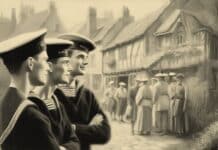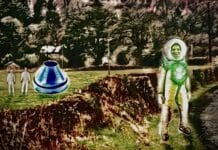Ghostly devil dogs – like Black Shuck the original Hound of the Baskervilles – have long been part of British folklore. Guest writer JON KANEKO-JAMES explains our fascination with these deadly phantom beasts.
WE have a fairly modern understanding of what a ghost is: the spirit of, usually, a human being who appears in either a visible or invisible form.
One of the things that really ties this together is the human part.
Certainly, in Medieval Britain they didn’t restrict the spirits of the dead to anywhere near a human form.
One Yorkshire Monk in the 14th Century wrote that his Parish was being terrified by a ghost manifesting itself as a storm of reeds with a bright, white light at the centre.
Other dead spirits appeared as birds or fish, possibly a dimly remembered development of the various ‘metamorphosis’ myths featured in such medieval books as the Mabinogion.
None of these are quite so haunting though, as the supernatural Black Dogs.
Black Shuck and Yeth Hounds
These predators are worse because they were once us.
In Cornwall and the West Country there are black dogs abounding: in 1677 a hunter was said to have sold his soul to the devil.
When he died diabolical hounds tore their way into his burial chamber and spirited his body away to their Satanic master.
In Cornwall the spirits of unbaptised infants are said to become the evil Yeth hounds, hunting lone travellers caught out on the moors at night.
In East Anglia we have the famous Black Shuck: the spirit of Hugh Bigod the Restless. He was the son of Roger Bigod, a kind, religious man and a government minister.
His older brother had been meant to inherit his father’s lands, but had died in the sinking of the White Ship, the Twelfth Century’s equivalent of the Titanic.
With no other heir, Hugh the Restless inherited, and the lands gave way to a reign of terror: he pillaged, he raped, he killed, and burned villages.
Eventually was taken to task by the King himself and tried to redeem himself by taking the crusader’s oath.
Unfortunately for him the burden of his actions was too great and he was excommunicated (by none other than the ‘turbulent priest,’ Thomas Beckett himself) dying in Palestine.
It was inevitable that his soul would want to take revenge, twisted by malice and tormented by devils.
They took him home, and then the attacks began.
At first, he merely attacked lone travellers, rending them with his teeth and ripping out their bowels.
Then, believe it or not, he got REALLY nasty.
He became a dominant figure in South-Eastern mythology. To see him was death. His pelt is deepest black, his teeth yellowed and slavering. Some even say that he only has one, huge, red eye.
Suffolk and Norfolk Massacres
They say that he comes down in the lightning. In Bungay and Blythburgh they knew this was true: in 1577 he came down in the lightning, appearing in Bungay church, running down the aisle.
All he touched died, two women withering to burned husks.
Others he killed by breaking their necks with his teeth. Moments later he appeared in Blythburgh church. The steeple was shattered and two were killed.
He even struck the town of Eccles-On-Sea with lightning in 1604, dropping it off the cliffs and into the sea… However there is redemption for the ‘Old Shucca’.
In 1864, two condemned criminals said that they had been frightened off from attacking a lone woman when the Old Shucca had stepped out of the shadows, menacing them with his powerful jaws.
Perhaps there might one day be a place behind the pearly gates awaiting Hugh Bigod after all?









